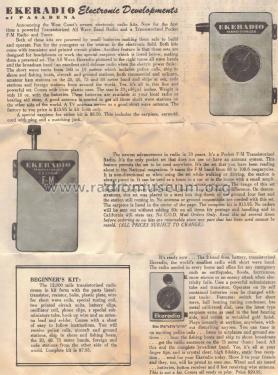Ekeradio Pocket F-M set and tuner
Ekeradio Electronic Developments; Pasadena CA
- Pays
- Etats-Unis
- Fabricant / Marque
- Ekeradio Electronic Developments; Pasadena CA
- Année
- 1951–1955
- Catégorie
- Radio - ou tuner d'après la guerre 1939-45
- Radiomuseum.org ID
- 322332
Cliquez sur la vignette du schéma pour le demander en tant que document gratuit.
- No. de tubes
- 1
- Lampes / Tubes
- unknown_Tube
- Principe général
- Récepteur TRF en général (avec ou sans réaction inconnu)
- Gammes d'ondes
- PO et Police / Maritime (150-200m)
- Tension / type courant
- Piles sèches / 1,5 & 30 Volt
- Haut-parleur
- - Seulement pour écouteur
- Matière
- Plastique moderne (pas de bakélite, ni de catalin)
- De Radiomuseum.org
- Modèle: Ekeradio Pocket F-M set and tuner - Ekeradio Electronic
- Forme
- Portable, appareil de poche. Taille < 20cm
- Dimensions (LHP)
- 4.5 x 2.75 x 1 inch / 114 x 70 x 25 mm
- Remarques
-
At least in 1954 Ekeradio offered a "beginners kit" transistor radio, a two band 8-oz. battery, transistorized Ekeradio, a transistorized custom F-M Ekeradio and a Transistorized "All wave Band Radio".
This Pocket F-M set and tuner:
It uses a subminiature tube only. Receives a range of 87.6 to 108.7 Mc, then including the channel 5 TV sound.The drawing of this Ekeradio Pocket F-M set and tuner is October 5, 1951. The "Thimble Set" was sold as a kit but Ekeradio wrote "there will be no kits or plans for this set". The designer was Glen Ecker, the owner of Ekeradio.
Offered was a "special High Frequency FM tube" called "Ekeradio" either for 60 (for $ 5.95) or for 30 (for $ 6.50) plate voltage. The midget tuning condenser U.H.F is for 2.7 to 15 Mmf. An Eveready "B" battery No. 413E or 507E for 30 volts (two in series for 60 volts) had to be carried outside the set. An "A" battery No. 935, size "C" for 1.5 volts was placed inside the set. The RF coil is winded with a 14 inches #26 enameled wire and soldered after 3 turns of the FM-tank coil.
A plan was included to build a two-stage amplifier with the popular 722 and 107 transistor. We have to know that at that time FM was not reachable by transistors, at the beginning not even short wave.
- Auteur
- Modèle crée par Ernst Erb. Voir les propositions de modification pour les contributeurs supplémentaires.
- D'autres Modèles
-
Vous pourrez trouver sous ce lien 3 modèles d'appareils, 2 avec des images et 1 avec des schémas.
Tous les appareils de Ekeradio Electronic Developments; Pasadena CA


